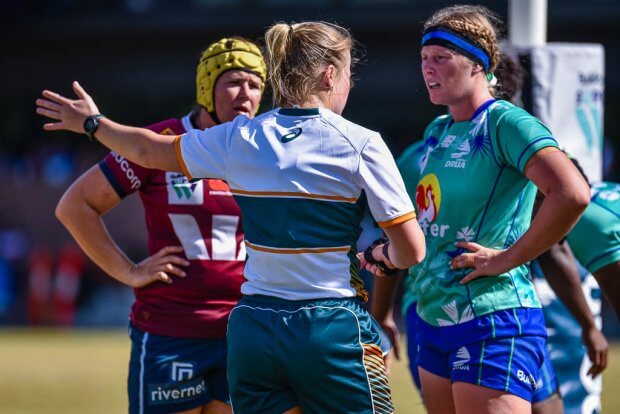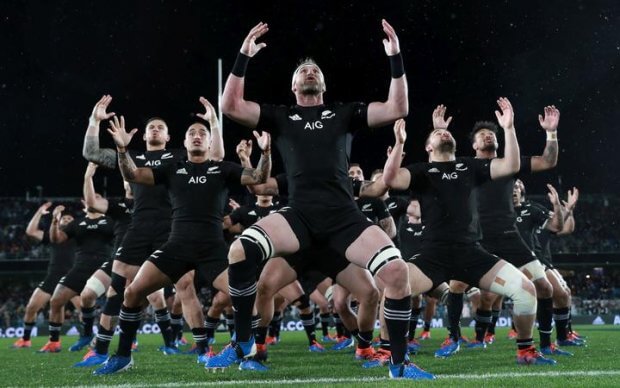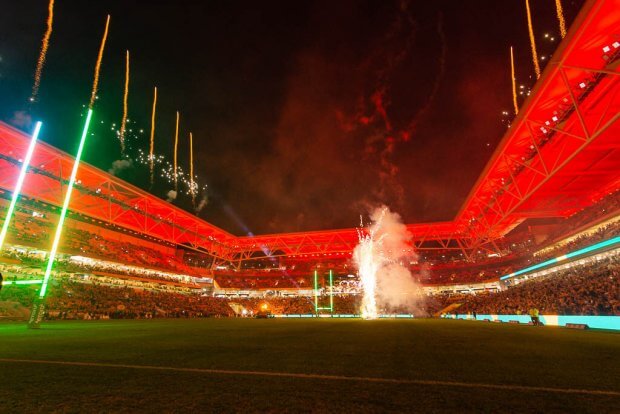Welcome fellow G&GRs to the penultimate week of rugby for 2024. With the Ireland v Australia match next weekend and Yowie doing the week’s news this is likely to be my last one for the year. Thank you, Hoss and the team, for giving me the opportunity to write my dribble and opinion pieces, and all of you for the support and fun times we’ve had. This site represents a lot of what I love about our game: a bunch of people with diverse ideas and different opinions enjoying the company, debates and differences, and still getting on and having fun.
Today, we put the disappointment of last week behind us and move on in the hope that things go our way this weekend. Good luck to the Wallabies.
Referee Corner



The biggest call from this week seemed to be the Ireland v Fiji match where, depending on whose side you took, the refereeing was racist and biased, or the Fijian players were just guilty of too much ill-discipline that cost them penalties and cards. I tend to go for the second option, but agree that at times referees can have a perception of teams that can affect some of the 50/50 calls (which is about 60% of them); it can be unfortunate when you’re on the wrong side of that. I disagree with any claims of racism and also struggle with a referee being biased. The racism I flat out deny and while I can see a subconscious bias in the 50/50 calls, the game moves far too fast for a referee to be consciously biased. It’d mean that they’d see an incident, think about how it can be twisted to favour one side and then make that call. There simply isn’t enough time for that to happen. By the time you went through that process three more things would’ve occurred, and you’d miss them and have to go back.
The main point of contention is the YC to Sam Prendergast for a high shot on Kitione Salawa that wasn’t upgraded. Unfortunately, in my office here in Sydney I can’t get Stan and the highlights online show everything but this incident so I can’t make any subjective comment on the tackle. What I can do though is go through the process and explain what the TMO would’ve had to consider, and more importantly from some, what he doesn’t have to consider. The law is easy. Law 9.11, 9.13 and 9.20 cover this well making it unlawful to do anything reckless or dangerous to others (11), not tackle late, early or dangerously and below the shoulder line (13) and not charge into a ruck or again above the shoulder line (20). World Rugby have also brought in a clear process for referees to follow and this is something that the TMO also has to follow.
Firstly, is their head contact? Yes, next step, or no, carry on. Secondly, was their foul play? Yes, next step, or no, carry on. The consideration for foul play includes: was it reckless, was it intentional and was it avoidable? If any of those three apply, then the foul play is yes. Thirdly, what was the degree of danger? This is one that usually goes to the TMO, mainly to prevent the situation where the referee and TMO have multiple on field discussions about it and play stops for five minutes while they do this. Personally, I like the process and while it’s a bit of a bob each way for the referee, it allows the game to move on. This is something we all asked for as well. The considerations for degree of danger include a direct v indirect blow – so shoulder then head is less than direct to head – and high force v low force. There’s no written direction on this and essentially, it’s at the discretion of the reviewer. This can be an issue with different TMOs having different opinions on this but generally it’s ok. The last step is, Is there any mitigation? Considerations here include: line of sight – so was the tackler fully sighted and not blocked from a clear view of the ball carrier i.e. Sam Cane v Ireland (that has so many Irish sooks squealing); sudden and significant drop or movement – so not a player crouching into the contact and must be both, not one or the other; clear attempt to change height – so did the tackler clearly change their height to go lower; level of control – was their time for the tackler to change or did he not have enough time (highly subjective but necessary) or was there interference from another player that contributed to the issue; and finally upright – mainly looking at passive v dynamic. So if a player was upright and went with the ball carrier down to the ground in the same direction as the ball carrier then it’s a passive tackle.
The TMO on this incident basically said yes to to the first two but ruled a low level of danger in the hit and some mitigation in that the Fiji player went down in the tackle and so the drop was sudden and significant enough to be considered. Now, I know many disagree with the calls, but the process was clearly followed and while the actual hit seemed to be a deliberate one, that just means it was foul play. Could the referee have ruled just on the deliberate or not and gone to red? Absolutely, however it was unlikely to go that way and to be fair to Holley, she wasn’t in a position to see it clearly so took the better option of letting it be reviewed. The TMO obviously saw it as reckless rather than deliberate and so didn’t take action on that. I think the process is a good and it both allows the game to continue and flow while providing the match officials with a recourse should the incident be worse than first seen in that split second it occurs. We might disagree with the view/opinion of the TMO, but there’s nothing new in that and we have to live with it.
The Haka

There has been a lot of talk recently about the haka and I think a lot of misunderstanding and conjecture about what it actually is and why New Zealand teams do it. This is only my opinion and I’m sure there are as many Kiwis as non-Kiwis who won’t agree with me on some parts of this. Please don’t take this as the golden truth, but more of how I feel about the haka and what it means to me. New Zealand does have a quite unique culture where the indigenous Maori have had their culture incorporated into a lot of the NZ community. In fact it has been inculcated so much that is now more of a New Zealand culture than a Maori culture. I think this is good and certainly how I see it. This is growing and Maori is now an official language in NZ. It was certainly a big part of my service with the New Zealand army where I was, and still am, a member of the Ngati Tumatauenga, the tribe of the God of War. An interesting part of this is how much it is part of the army. The marae, or meeting house for most tribes, has the entrance facing the east to see the rising sun on a new day; the army marae faces the west because we protect NZ from the darkness. The haka itself is a challenge and most see it as that; however, it is also much more and is actually a very significant sign of respect. While most rugby fans only see it at the start, or end of a game, and watching two 1st XV teams challenge each other at the same time with the school spectators joining in from the side is an awesome sight (go YouTube it if you want); however, it is not just a challenge. There are also many hakas and almost every unit and corps in the army has their own haka they will use when most appropriate. This is the same throughout NZ and all tribes, and even sub-tribes, have their own haka that they will use.
In everyday life the haka is used very much as a sign of respect. One of my most precious moments was being farewelled from a unit where the staff gave me a haka as I left. It is used at funerals, births, farewells, welcomes and other significant events where the people want to show respect for someone, or some group and is a show of pride, strength and unity. A huge part of why the All Blacks do a haka is that they are acknowledging the opposition as being the best of their country about to play a game against the best of NZ. They are showing their respect for the opposition and at the same time challenging them to come to the party, play their best and show that they deserve to be in that team and play in the game. While some aspects of the haka, such as the throat cutting sign upset some, this isn’t meant as a sign of disrespect, but that the intensity of the approaching battle is high and that it is a battle to the end. They are also showing a sign of unity with the players of both teams being unified in playing this wonderful game together in the spirit of the game and while leaving everything on the field being able to come together after the game in that unified way.
An interesting side of the game is the perception that the haka gives the ABs an advantage and it should be banned for this reason. While there is some truth in this, and having participated in a few hakas at the start of a game it does fire you up. However, there is also empirical evidence that the haka is a huge reason why the ABs start so slowly at times. The players are emotionally fired up, but they need to come down from that level to play the game, and quite often during the first 15 minutes or so they don’t play well as they descend from the high and refocus. Perhaps something the opposition should take advantage of.
This is my view of the haka; I consider the cultural side of this as New Zealand culture, not Maori v European culture. I am extremely proud to be a member of Ngati Tumatauenga and I see this as a huge part of me as a New Zealander. While I am now also an Australian citizen, the New Zealand culture will also always be a huge part of who I am as a person.
World Players of the Year.

Reported here in World Rugby, Pieter-Steph du Toit (South Africa) has been named as the men’s XV player of the year with Ellie Kildunne (England) being named the women’s XV player of the year.
Anton Dupont (France) and Maddi Levi (Australia) named in the men’s and women’s 7s players of the year with Wallace Sititi (New Zealand) and Erin King (Ireland) named as the breakout players of the year.
Jerome Daret (France) named coach of the year – the first time a 7s coach has won this award and a huge indicator of the growth of this game and its growing importance at events like the Olympics.
Congratulations to all the winners it is fantastic for all of them and great for this game we love. If you can find Maddi’s thank you speech on line it is well worth listening to. She really is an awesome human as well as being a fantastic player.
I feel that at times this can resemble the idea of someone picking a “team of the week” in a competition and there’ll always be people who have their preferences and can get a tad upset when they aren’t picked. However, for me even if you don’t think any of them are totally correct because “your” player wasn’t picked, I don’t think you can deny that they are all very good and deserve to be up there.
Have a great Hump Day G&GRs. It’s Happyman tomorrow.


